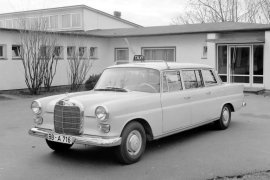Mercedes-Benz introduced a seven-seat, long-wheelbase option for the E-Class, designed either for taxi drivers or for executive orders.
The German carmaker introduced the 190 model in 1961 with a new design detail that brought it the fintail-body nickname. It replaced the “ponton” range with larger, more commanding-looking vehicles. Mercedes-Benz built the 190 based on the 220b model, with the same front and rear axles carried over. The solution led to lower development costs and helped the carmaker on the market.
At the front, it kept the same front fascia with a narrow and tall grille, mounted straight-up in front of the hood. In front of it, on the lower side, the carmaker installed a chromed metallic bumper wrapped around the front corners. Up to the B-pillars and from the rear windscreen, it used the same parts as the regular version. The rear doors didn’t have a cut for the rear wheels and, behind them, the carmaker added a longer quarter panel and an additional window for the last row of seat passengers. In the back, the narrow and tall fenders formed a tail, from which the car received its nickname.
Inside, the sloped and narrow dashboard featured a taller area for the instrument cluster. The carmaker installed either vertical dials with sliders or round dials for the speedometer and the oil pressure, coolant temperature, and fuel level gauges. Between them, on the upper side, Mercedes-Benz installed a clock. The carmaker placed a tilt and tumble seat for the middle row, which allowed the ingress and egress for the rear passengers.
Under the hood, Mercedes-Benz installed a 1.9-liter, inline-four engine for the base model. Later on, the carmaker added an inline-six and a four-pot diesel.

























































